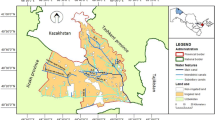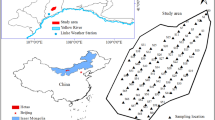Abstract
Information about the spatiotemporal variability of soil salinity is important for managing salinization in gravel–sand mulched fields. We used inverse distance weighting (IDW) and cokriging to model the spatial variability of soil salinity from 2013 to 2016 and used an autoregressive moving-average (ARMA) model time series to analyze the temporal variability. The objectives of this paper are (a) to compare IDW and cokriging for predicting salinity in deep soil layers from surface data, thus finding a more appropriate method to model the spatial variability of soil salinity, and, using ARMA time series, (b) to identify one or a few sampling points, where soil salt content is the most temporally stable, to increase sampling efficiency or decrease cost and to estimate the overall soil salt content of a field. The IDW interpolation was more accurate than cokriging when using surface salt content to estimate the content in deep layers; so, we used IDW to interpolate the data and draw spatial distribution maps of salt content. Salinity in the 0–10 cm layer gradually decreased with the amount of gravel–sand mulching, from 1.02 to 0.7 g/kg over four years, and increased with depth. ARMA was accurate when using sample dates to predict soil salinity in the time series, and the model was more stable. The stability of the salt spatial patterns over time and along the soil profile allowed us to identify a location representative of the field-mean salt content, with mean relative error ranging between 0.56 and 2.19%. The monitoring of soil salt from a few observations is thus a valuable tool for practitioners and will aid the management of soil salt in gravel–sand-mulched fields in arid regions, with a range of potential applications beyond the framework of monitoring salinity.







Similar content being viewed by others
References
Baroni, G., Ortuani, B., Facchi, A., & Gandolfi, C. (2013). The role of vegetation and soil properties on the spatio-temporal variability of the surface soil moisture in a maize-cropped field. Journal of Hydrology, 489(3), 148–159.
Brocca, L., Moramarco, T., Melone, F., Wagner, W., Hasenauer, S., & Hahn, S. (2012). Assimilation of surface and root-zone ASCAT soil moisture products into rainfall-runoff modeling. IEEE Transactions on Geoscience and Remote Sensing, 50(7), 2542–2555.
Cemek, B., Güler, M., Kilic, K., Demir, Y., & Arslan, H. (2007). Assessment of spatial variability in some soil properties as related to soil salinity and alkalinity in Bafra plain in northern Turkey. Environmental Monitoring and Assessment, 124, 223–234.
Contreras-Cruzado, I., Infante-Izquierdo, M. D., Márquez-García, B., Hermoso-López, V., Polo, A., Nieva, F. J. J., Cartes-Barroso, J. B., Castillo, J. M., & Muñoz-Rodríguez, A. (2017). Relationships between spatio-temporal changes in the sedimentary environment and halophytes zonation in salt marshes. Geoderma, 305, 173–187.
Corwin, D. L., Lesch, S. M., Oster, J. D., & Kaffka, S. R. (2006). Monitoring management-induced spatiotemporal changes in soil quality through soil sampling directed by apparent electrical conductivity. Geoderma, 131(3–4), 369–387.
Douaoui, A. E. K., Nicolas, H., & Walter, C. (2006). Detecting salinity hazards within a semiarid context by means of combining soil and remote-sensing data. Geoderma, 134, 217–230.
Duncan, R. A., Bethune, M. G., Thayalakumaran, T., Christen, E. W., & Mcmahon, T. A. (2008). Management of salt mobilisation in the irrigated landscape—a review of selected irrigation regions. Journal of Hydrology, 351(1–2), 238–252.
Eldeiry, A. A., & Garcia, L. A. (2010). Comparison of ordinary kriging, regression kriging, and cokriging techniques to estimate soil salinity using Landsat images. Journal of Irrigation and Drainage Engineering, 136(6), 355–364.
Fan, Y., Weisberg, P. J., & Nowak, R. S. (2014). Spatio-temporal analysis of remotely-sensed forest mortality associated with road de-icing salts. Science of the Total Environment, 472(472C), 929–938.
Garten, C. T., Jr., Kang, S., Brice, D. J., Schadt, C. W., & Zhou, J. (2007). Variability in soil properties at different spatial scales (1 m-1 km) in a deciduous forest ecosystem. Soil Biology and Biochemistry, 39, 2621–2627.
González-Alcaraz, M. N., Jiménez-Cárceles, F. J., Álvarez, Y., & Álvarez-Rogel, J. (2014). Gradients of soil salinity and moisture, and plant distribution, in a Mediterranean semiarid saline watershed: a model of soil–plant relationships for contributing to the management. Catena, 115(3), 150–158.
Grunstra, M., & Van Auken, O. W. (2007). Using GIS to display complex soil salinity patterns in an inland salt marsh. Developments in Environmental Sciences, 5, 407–431.
Hamzehpour, N., & Bogaert, P. (2017). Improved spatiotemporal monitoring of soil salinity using filtered kriging with measurement errors: an application to the West Urmia Lake, Iran. Geoderma, 295, 22–33.
He, B., Cai, Y. L., Ran, W. R., Zhao, X. L., & Jiang, H. (2015). Spatiotemporal heterogeneity of soil salinity after the establishment of vegetation on a coastal saline field. Catena, 127(4), 129–134.
Hingerl, L., Kunstmann, H., Wagner, S., Mauder, M., Bliefernicht, J., & Rigon, R. (2016). Spatio-temporal variability of water and energy fluxes—a case study for a mesoscale catchment in pre-alpine environment. Hydrological Processes, 30(21), 3804–3823.
Huang, C. Y., & Xu, J. M. (2010). Soil science (third edition) [M]. Chinese agriculture.
Hussain, G., & Alshammary, S. F. (2008). Effect of water salinity on survival and growth of landscape trees in Saudi Arabia. Arid Land Research & Management, 22(4), 320–333.
Ibrahimi, M. K., Miyazaki, T., Nishimura, T., & Imoto, H. (2014). Contribution of shallow groundwater rapid fluctuation to soil salinization under arid and semiarid climate. Arabian Journal of Geosciences, 7(9), 3901–3911.
Ji, Q., & Yu, M. (2010). Study on parameters setting of ordinary cokriging interpretation to average annual temperature. Journal of Capital Normal University, 31(4), 81–87.
Juan, P., Mateu, J., Jordan, M. M., Mataix-Solera, J., Meléndez-Pastor, I., & Navarro-Pedreño, J. (2011). Geostatistical methods to identify and map spatial variations of soil salinity. Journal of Geochemical Exploration, 108(1), 62–72.
Lei, Z. D., Yang, S. X., & Xie, S. C. (1988). Soil hydrodynamics. [M]. Beijing: Tsinghua University.
Lesch, S. M., Rhoades, J. D., Lund, L. J., & Corwin, D. L. (1992). Mapping soil salinity using calibrated electromagnetic measurements. Soil Science Society of America Journal, 56, 540–548.
Li, X. Y. (2003). Gravel-sand mulch for soil and water conservation in the semiarid loess region of northwest China. Catena, 52(2), 105–127.
Li, X. Y., Gong, J. D., Gao, Q. Z., & Wei, X. H. (2000). Rainfall interception loss by pebble mulch in the semiarid region of China. Journal of Hydrology, 228(3), 165–173.
Li, X. Y., Shi, P. J., Liu, L. Y., Gao, S. Y., Wang, X. S., & Cheng, L. S. (2005). Influence of pebble size and cover on rainfall interception by gravel mulch. Journal of Hydrology, 312, 70–78.
Li, Y., Shi, Z., Wu, C. F., Li, H., & Li, F. (2007). Improved prediction and reduction of sampling density for soil salinity by different geostatistical methods. Agricultural Sciences in China, 6(7), 832–841.
Li, H. Y., Marchant, B. P., & Webster, R. (2016). Modelling the electrical conductivity of soil in the Yangtze delta in three dimensions. Geoderma, 269, 119–125.
Liu, J. L., Ma, X. Y., Zhang, Z. H., & Fu, Q. (2014). Temporal stability of soil moisture in an orchard. Journal of Basic Science and Engineering, 22(4), 698–703.
Lu, G. Y., & Wong, D. W. (2008). An adaptive inverse-distance weighting spatial interpolation technique. Computers & Geosciences, 34(9), 1044–1055.
Lü, H. S., Yu, Z. B., Horton, R., & Yang, C. G. (2013). Effect of gravel-sand mulch on soil water and temperature in the semiarid loess region of Northwest China. Journal of Hydrologic Engineering, 18(11), 1484–1494.
Mahmut, C., & Cevat, K. (2003). Spatial and temporal changes of soil salinity in a cotton field irrigated with low-quality water. Journal of Hydrology, 272, 238–249.
Nachshon, U., Ireson, A., Kamp, G. V. D., & Wheater, H. (2013). Sulfate salt dynamics in the glaciated plains of North America. Journal of Hydrology, 499, 188–199.
Nouwakpo, S. K., Weltz, M. A., McGwire, K. C., Williams, J. C., Osama, A. H., & Green, C. H. M. (2017). Insight into sediment transport processes on saline rangeland hillslopes using three-dimensional soil microtopography changes. Earth Surface Processes & Landforms, 42(4), 681–696.
Scudiero, E., Skaggs, T. H., & Corwin, D. L. (2016). Comparative regional-scale soil salinity assessment with near-ground apparent electrical conductivity and remote sensing canopy reflectance. Ecological Indicators, 70, 276–284.
Sonmez, S., Buyuktas, D., Okturen, F., & Citak, S. (2008). Assessment of different soil to water ratios (1:1, 1:2.5, 1:5) in soil salinity studies. Geoderma, 144(1), 361–369.
Tejedor, M., Jiménez, C., & Díaz, F. (2003). Volcanic materials as mulches for water conservation. Geoderma, 117(3), 283–295.
Tripathi, R., Nayak, A. K., Shahid, M., Raja, R., Panda, B. B., Mohanty, S., Kumar, A., Lal, B., Gautam, P., & Sahoo, R. N. (2015). Characterizing spatial variability of soil properties in salt affected coastal India using geostatistics and kriging. Arabian Journal of Geosciences, 8(12), 10693–10703.
Tunçay, T., Bayramin, İ., Atalay, F., & Ünver, İ. (2016). Assessment of inverse distance weighting (IDW) interpolation on spatial variability of selected soil properties in the Cukurova Plain. Tarim Bilimleri Dergisi-Journal of Agricultural Sciences, 22(3), 377–384.
Veeneklaas, R. M., Dijkema, K. S., Hecker, N., & Bakker, J. P. (2013). Spatio-temporal dynamics of the invasive plant species Elytrigia atherica on natural salt marshes. Applied Vegetation Science, 16(2), 205–216.
Visconti, F., Paz, J. M. D., & Rubio, J. L. (2010). What information does the electrical conductivity of soil water extracts of 1 to 5 ratio (w/v) provide for soil salinity assessment of agricultural irrigated lands? Geoderma, 154(3–4), 387–397.
Wang, X. P., Pan, Y. X., Zhang, Y. F., Dou, D. Q., Hu, R., & Zhang, H. (2013). Temporal stability analysis of surface and subsurface soil moisture for a transect in artificial revegetation desert area, China. Journal of Hydrology, 507(11), 100–109.
Wu, Y. K., Liu, G. M., Yang, J. S., She, S. P. (2013). Interpreting method of regional soil salinity 3D distribution based on inverse distance weighting. Transactions of the Chinese society of agricultural engineering, 29(3), 100-106.
Yu, S. H., Liu, J. T., Eneji, A. E., Liu, H. T., & Han, L. P. (2015). Spatial variability of soil salinity under subsurface drainage. Communications in Soil Science & Plant Analysis, 46(2), 259–270.
Zhao, Y., Peth, S., & Wang, X. Y. (2010). Controls of surface soil moisture spatial patterns and their temporal stability in a semi-arid steppe. Hydrological Processes, 24(18), 2507–2519.
Zhao, W. J., Cui, Z., Zhang, J. Y., & Jin, J. (2017a). Temporal stability and variability of soil-water content in a gravel-mulched field in northwestern China. Journal of Hydrology, 552, 249–257.
Zhao, W. J., Sheng, J., Li, Z. L., Ma, H., & Yu, P. (2017b). Spatial variability of soil salinity in a gravel-sand mulched jujube orchard at different scales. Journal of Irrigation and Drainage Engineering, 143(6), 04017009.
Zou, P., Yang, J. S., Fu, J. R., Liu, G. M., & Li, D. S. (2010). Artificial neural network and time series models for predicting soil salt and water content. Agricultural Water Management, 97(12), 2009–2019.
Zucco, G., Brocca, L., Moramacro, T., & Morbidelli, R. (2014). Influence of land use on soil moisture spatial-temporal variability and monitoring. Journal of Hydrology, 516(6), 193–199.
Acknowledgments
This study was supported by the National Natural Science Foundation of China (51869010), the Longyuan Youth Innovation and Entrepreneurship Project, and the Hongliu discipline funding from Lanzhou University of Technology.
Author information
Authors and Affiliations
Corresponding author
Additional information
Publisher’s note
Springer Nature remains neutral with regard to jurisdictional claims in published maps and institutional affiliations.
Rights and permissions
About this article
Cite this article
Zhao, W., Cao, T., Li, Z. et al. Comparison of IDW, cokriging and ARMA for predicting spatiotemporal variability of soil salinity in a gravel–sand mulched jujube orchard. Environ Monit Assess 191, 376 (2019). https://doi.org/10.1007/s10661-019-7499-8
Received:
Accepted:
Published:
DOI: https://doi.org/10.1007/s10661-019-7499-8




